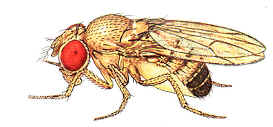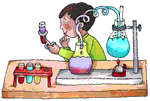| Genetics of Drosophila melanogaster |  |
 |
|
Introduction:
Gregor Mendel revolutionized the study of genetics. By studying genetic inheritance in pea plants, Gregor Mendel established two basic laws of that serve as the cornerstones of modern genetics: Mendel’s Law of Segregation and Law of Independent Assortment. Mendel’s Law of Segregation says that each trait has two alleles, and that each gamete contains one and only one of these alleles. These alleles are a source of genetic variability among offspring. Mendel’s Law of Independent Assortment says that the alleles for one trait separate independently of the alleles for another trait. This also helps ensure genetic variability among offspring.
Mendel’s laws have their limitations. For example, if two genes are on the same chromosome, the assortment of their alleles will not be independent. Also, for genes found on the X chromosome, expression of the trait can be linked to the sex of the offspring. Our knowledge of genetics and the tools we use in its study have advanced a great deal since Mendel’s time, but his basic concepts still stand true.
Drosophila melanogaster, the common fruit fly, has been used for genetic experiments since T.H. Morgan started his experiments in1907. Drosophila make good genetic specimens because they are small, produce many offspring, have easily discernable mutations, have only four pairs of chromosomes, and complete their entire life cycle in about 12 days. They also have very simple food requirements. Chromosomes 1 (the X chromosome), 2, and 3 are very large, and the Y chromosome – number 4 – is extremely small. These four chromosomes have thousands of genes, many of which can be found in most eukaryotes, including humans.
Drosophila embryos develop in the egg membrane. The egg hatches and produces a larva that feeds by burrowing through the medium. The larval period consists of three stages, or instars, the end of each stage marked by a molt. Near the end of the larval period, the third instar will crawl up the side of the vial, attach themselves to a dry surface, and form a pupae. After a while the adults emerge.
Differences in body features help distinguish between male and female flies. Females are slightly larger and have a light-colored, pointed abdomen. The abdomen of males will be dark and blunt. The male flies also have dark bristles, sex combs, on the upper portion of the forelegs.
Hypothesis:
After performing a dihybrid cross between males with normal wings and sepia eyes and females with vestigial wings and red eyes, we expect to see only hybrids with normal wings and red eyes in the first filial generation. Then we expect to observe a 9:3:3:1 ratio of phenotypes in the second filial generation.
Materials and Methods:
The materials used for this lab were: culture vial of dihybrid cross, isopropyl alcohol 10%, camel’s hair brush, thermo-anesthetizer, petri dish, 2 Drosophila vials and labels, Drosophila medium, fly morgue.
A vial of wild-type Drosophila was thermally immobilized and the flies were placed in a petri dish. Traits were observed. A vial of prepared Drosophila was immobilized and then observed under a dissecting microscope. Males and females were separated and mutations were observed and recorded. The parental generation was placed in the morgue. The vial was placed in an incubator to allow the F1 generation to mature.
The F1 generation was immobilized and examined under a dissecting microscope. The sex and mutations of each fly were recorded. Five mating pairs of the F1 generation were placed into a fresh culture vial, and the vial was placed in an incubator. The remaining F1 flies were placed in the morgue. The F1 flies were left in the vial for about a week to mate and lay eggs. Then the adults were removed and placed in the morgue. The vial was placed back in the incubator to allow the F2 generation to mature. The F2 generation was immobilized and examined under a dissecting microscope. The sex and mutations of each fly were recorded.
Results:
Table 1 Phenotypes of the Parental Generation
| Phenotypes | Number of Males | Number of Females |
| Normal wings/red eyes | 0 | 0 |
| Normal wings/sepia eyes | 3 | 0 |
| vestigial wings/red eyes | 0 | 4 |
| vestigial wings/sepia eyes | 0 | 0 |
Table 2 Phenotypes of the F1 Generation
| Phenotype | Number of Males | Number of Females |
| Normal wings/red eyes | 78 | 95 |
| Normal wings/sepia eyes | 0 | 0 |
| vestigial wings/red eyes | 0 | 0 |
| vestigial wings/sepia eyes | 0 | 0 |
Table 3 Phenotypes of the F2 Generation
| Phenotypes | Number of Males | Number of Females |
| Normal wings/red eyes | 4 | 7 |
| Normal wings/sepia eyes | 4 | 5 |
| vestigial wings/red eyes | 0 | 1 |
| vestigial wings/sepia eyes | 0 | 0 |
| normal red/mutated body shape | 2 | 0 |
| normal sepia/mutated body shape | 1 | 0 |
Questions
- How are the alleles for genes on different chromosomes distributed to gametes? What genetic principle does this illustrate?
The alleles on different chromosomes are distributed independently of one another, demonstrating Mendel’s Law of Independent Assortment.
- Why was it important to have virgin females for the first cross (yielding the F1 generation), but not the second cross (yielding the F2 generation)?
It was important to have virgin females for the first cross to ensure that the offspring are the result of the desired cross. It was not necessary to isolate virgin females for the second cross because the only male flies to which they had been exposed were also members of the F1 generation.
- What did the chi-square test tell you about the validity of your experiment data? What is the importance of such a test?
The chi-square test showed that the results of our first cross were valid, but that the results of our F1 cross were not normal. It is important to conduct such a test to determine how much your experimental data deviated from what was expected.
Discussion and Conclusion:
The results of our parental cross turned out just as expected, but our F2 generation was not normal. Some sort of mutation must have occurred that caused the strange body shape seen in several individuals of our F2 generation.



